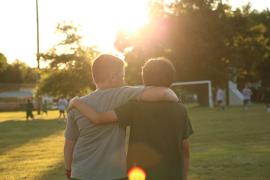It was three years ago when I first wrote about the increasing levels of anxiety that camp directors were seeing in their staff (Ditter, 2016). At the time, the Centers for Disease Control and Prevention (CDC) in Atlanta had been reporting that anxiety in children ages 13–18 was at a 40-year high (CDC, 2011). In a survey conducted by the American Camp Association’s Healthy Camps Committee after the summer of 2015, camp directors indicated that anxiety was their number one concern when it came to staff (Gaston, 2015).
If anything, in the intervening three years, the problem has gotten worse. The National Institute for Mental Health (NIMH) recently reported that an estimated 31.9 percent of adolescents ages 13–18 will have a formally diagnosed anxiety disorder at some point in their lifetime (NIMH, 2017). These are numbers so large that I actually called to make sure it wasn’t a misprint.
Probable Cause
While no one has a definitive answer as to what is causing such high levels of anxiety in young people, let me offer a few possibilities, starting with social media. The current generation of children ages 8–21, which many people refer to as “Gen Z,” has grown up never knowing a time when there was no social media or a screened device that traveled with you everywhere you went. According to the Pew Research Center, probably the most authoritative source on the use of technology by young people in the United States today, 72 percent of teens say they use Instagram, 69 percent say they use Snapchat, and 51 percent say they use Facebook, each one multiple times a day (Anderson & Jiang, 2018).
What young people typically post on social media is an enhanced, photoshopped version of who they are. It is the party they went to, not the party they missed; the test they aced, not the one they failed; the school they got into, not the ones they were rejected by or wait-listed at; the outing they were a part of, not the ones where they were left behind; the date they had, not the nights they stayed home; and the trip they took, not the ones they wished they had gone on. What this all adds up to is fear of missing out (FOMO) — when you see everyone else’s best and “most perfect” moments, it leaves you with this constant, nagging sense that your life pales by comparison — that, indeed, you are “missing out.” Social media emphasizes what we don’t have, rather than what we do have. It is a constant measuring of ourselves against a standard we can never achieve.
We all have a tendency to compare our insides with everyone else’s outsides. Social media increases this tendency, creating the false notion that there is such a thing as “the perfect life,” the one all of us are obviously not living! What I hear from the young people I speak with at camps across the country and in my psychotherapy practice in Boston is the sense of having to live up to some impossible, perfect standard of being. As a young adult who I had seen in my practice said to me when he was home on break after his first semester in college, “You can’t help but compare yourself and wonder why your life isn’t as glamorous or wonderful. It’s like you can never be enough.” This perception is a corruption of reality. The truth is that there are only moments of perfection, many of which have nothing to do with personal performance or achievement, but with a deep, meaningful connection to others and the natural world.
Indeed, what most people leave out of their social media personas is precisely what makes us human — our fears, vulnerabilities, unfulfilled wishes and desires, imperfections, and struggles. When we cut off from expression those things that make up our vulnerable side and mix it in with a standard we can never meet, we create a situation ready-made for anxiety. As Ruth Whippman, author of America the Anxious: How Our Search for Happiness Is Creating a Nation of Nervous Wrecks, says, “I find that only a small percentage of my job is actually doing my job. The rest is performing millions of acts of tweeting, posting, liking, disliking, sharing, and retweeting. All of it an attempt to sell a semi-fictional, much more appealing version of myself” (Whippman, 2016).
A Second Suspect
By now there is hardly anyone who has not heard about the “helicopter parenting” trend. This phrase was first used by child psychologist Haim Ginott, PhD, in his 1969 book, Between Parent & Teenager, by teens who said their parents would “hover over them like a helicopter.” By 2011, the term had become synonymous with the tendency of anxious parents to hover around their kids, becoming intensely involved in their schoolwork, friendships, and activities, and enrolling them in any and every activity that might give them a leg up. (Another term associated with helicopter parents is “snow plow” or “lawn mower” parents, who attempt to “pave the way” for their children in whatever endeavor they presume to pursue).
This style of parenting has created some unhelpful side-effects, the most notable of which is the lack of resilience in kids raised in this way. It turns out that if you constantly pave the way for your kids or do so much for them that they end up “not doing for themselves,” even if those efforts are well-intentioned, those children are less likely to develop their own coping skills. As Lynn Lyons, LCSW, a social worker from New Hampshire who works extensively with anxious children and teens, says, “When parents accommodate for their kids, they deprive them of the opportunity to develop their own coping strategies, including the ability to tolerate the stress that typically comes with life’s challenges.” Children today, she notes, think that the tightness they feel in their chest or the pit they feel in their stomach means that something is terribly wrong instead of recognizing this unpleasantness as the common somatic symptoms of everyday stress (Lyons, 2018).
Camp: Managing, Not Treating Anxiety
It is important to remember that, while certainly having many therapeutic benefits, most camps are not treatment facilities! While camps can do many things to help staff better manage their stress, there will always be a handful of young adults who are just not ready to be in a camp environment. Remember, your staff needs to be able to do the entire job you have for them, not just the parts they would like to pick and choose.
With that in mind, several factors can help your staff manage their anxiety better. Sleep, the smart use of short breaks, light exercise, having allies at camp to help share the emotional and social burdens of the job, and good use of time off not only help us alleviate anxiety, but they have a prophylactic effect that tends to inoculate us against anxiety, making us less susceptible to drifting into that negative mind space.
Staff Self-Care Plan
Last summer, many camps began having talks with their staffs on anxiety, looking not just at what might be causing it in such high numbers, but also framing the discussion in terms of the normal stressors at camp. While camp can be a terrific place to be for the summer — being outdoors, being active, having fun with campers — like any real job, it comes with its share of stressors. Hot and/or humid weather, long days, less privacy, campers who test our patience, being away from other friends and family — these can all be stressful for any staff member, even if they are having a blast at camp.
Many camps also invite their staff to create a self-care plan for themselves for the summer. Looking at some of the factors that help us manage or even reduce anxiety in our lives, such as getting plenty of sleep, engaging in some moderate aerobic exercise, having a connection to trusted allies at camp, and so on, the self-care plan is a way for staff to think ahead and take the pressures or demands of camp in stride.
Five important factors should be a part of anyone’s self-care plan:
- Sleep. When it comes to managing stress, sleep is critical. Most people need eight to nine hours of sleep. (Campers need more!) Getting sleep on a regular basis is a crucial part of your self-care plan. If you make a habit of staying up late, it will catch up with you. Try getting to bed early at least one night during the week.
- Short breaks: Meditate/Breathe. This can be a moment-to-moment practice or a daily habit for you. This category has a range of practices, such as the following:
- Momentary meditations
- Prayer, even if just brief prayers on your way from one location to anothe
- Journaling, which is just a more formal way of reflectin
- Moments of gratitude
It is helpful to incorporate many moments throughout your day, even if they last for only a minute or two. The idea is to quiet your mind for a few minutes.
- Light, daily exercise. Moving (aerobic exercise) every day can not only help cut stress, but also inoculate you against stress. It will help you sleep better at night. Walking raises testosterone (coping hormone) and lowers cortisol (stress hormone) levels.
- Plan ahead for your time off! One of the biggest mistakes counselors make is not using time off wisely. Have something to look forward to that also gives you some rest. Anticipating a break — a night out, a phone call, a partial day off, or a full day off — is almost as good as the break itself. We get to count down to the time when we can let up a little. Beware of exhausting yourself on a day off.
- Have trusted allies. We all need people in our immediate community who we can trust just to vent to and connect with — people with whom we feel safe and with whom we can talk in an honest way without fear of judgment or reprisals.
References
Anderson, M. & Jiang, J. (2018, May 31). Teens, social media & technology 2018. Pew Research Center. Retrieved from pewinternet.org/2018/05/31/teens-social-media-technology-2018/
Centers for Disease Control and Prevention. (2011). Report on Health Care Provider Diagnosis and Medication Mental Health, United States, 2003–2011.
Ditter, B. (2016, September). Staff anxiety — The new normal. Camping Magazine. Retrieved from ACAcamps.org/resource-library/staff-anxiety-new-normal
Gaston, T. (lead author). (2015). The healthy camps summer 2015 survey. Martinsville, IN: American Camp Association.
Ginott, Haim. (1969). Between Parent & Teenager. New York, NY: Macmillan.
Lyons, L. (2018, October). Treating anxiety in children and teens, presentation at the Harvard Medical School Conference on Issues in School-Age Children, October, 2018.
National Institute of Mental Health. (2017). National comorbidity survey adolescent supplement. Prevalence of Anxiety Disorders in Adolescents, 2017. Retrieved from nimh.nih.gov/health/statistics/any-anxiety-disorder.shtml
Whippman, R. (2016). America the anxious: How our search for happiness is creating a nation of nervous wrecks. New York, NY: St. Martin’s Press.
Bob Ditter is a licensed clinical social worker specializing in child, adolescent, and family therapy. Bob can be reached at [email protected].



